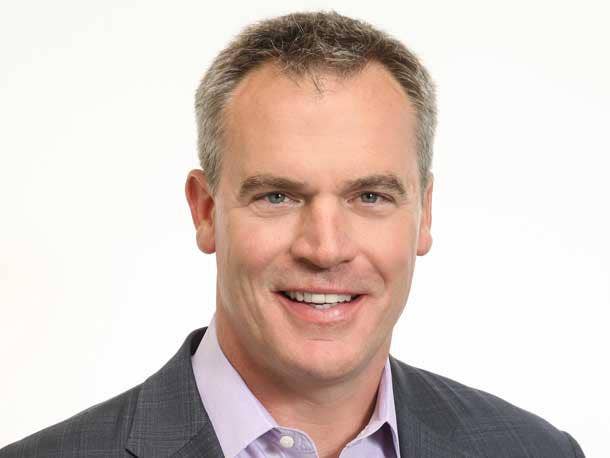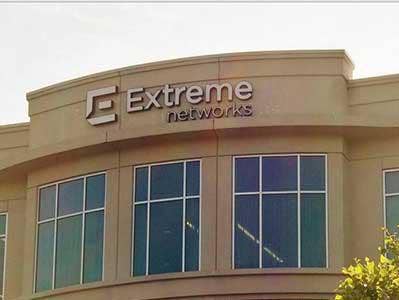Extreme Networks CEO: ‘These Are Boon Times For Our Channel Partners’
‘If you think about the idea [of everything] built into the network—access control and security around the network layer, the application layer and then, of course, users and identity—this is really what security is about. There are not many solutions out there, certainly that we’re aware of, where you get all three in one,’ Extreme CEO Ed Meyercord tells CRN about the networking specialist’s universal platform and new security elements.

Networking specialist Extreme Networks, a smaller but mighty player in the market compared with some of the competition, has spent the past years growing with the help of its differentiated cloud networking platform and universal hardware, which provide choice and simplicity for customers.
The work is paying off. During its most recent fiscal quarter, Extreme’s revenue was up 19 percent year over year to $353.1 million, with cloud adoption and system bookings driving 30 percent of the company’s growth in SaaS ARR, which was $141.0 million alone during the quarter. The company said that much of its revenue growth was fueled by an increase in large deals worth more than $1 million. At the same time that Extreme posted stronger-than-expected fiscal first-quarter 2024 results, however, the company lowered its expected revenue growth to mid- to high single digits, a result of lower product orders as businesses and channel partners “digest” and implement the gear they now have access to as massive supply backlogs clear across the entire networking industry, according to Extreme President and CEO Ed Meyercord.
Another path to growth, according to Meyercord, will be via the ExtremeCloud Universal Zero Trust Network Access, an offering that combines network, application and device security all within a single tool—something competitors don’t offer today, Morrisville, N.C.-based Extreme said.
Meyercord caught up with CRN to talk about the company’s developing cloud and universal platform story and how that story is resonating with partners and end customers. He also shared how combining networking and security will be key moving forward and a big differentiator for partners that can do it—rather than offering point security products.
Here’s what Meyercord had to say.

How have partners contributed to Extreme’s most recent fiscal quarter of growth in networking, security and subscriptions?
As you know, we put up 19 percent growth [in first-quarter 2024]. And I think the channel is very healthy because the channel is digesting all this backlog that is being released. From a project perspective, our channel partners are busy at work implementing our technology and networking solutions. So from that standpoint, these are boon times for our channel partners. Back in the early days of the pandemic, if you think about it, there were constraints and it was difficult, but now the spigot is open, the products are flowing, and the channel is very healthy and we saw that with our financial results in terms of overall 19 percent revenue growth year over year. It’s pretty clear we’re still taking share in the marketplace.
The other thing that we’re looking at is customers over $1 million. For us, we continue to move upmarket as people become aware of our technology differentiation as we do a better job as a company spreading the word on the kinds of customers that are there making the move to Extreme and the kinds of customers that are committing to networking and the networking security elements with Extreme Networks. It’s approval. It’s validation for the technology, and we’re delighted [to see] another 30 customers over $1 million during the quarter with Extreme. The other thing we’re highlighting is a move to subscription. Our initial foray into the cloud was really cloud management. We’ve done a nice job, with over 65 percent of our sales today in terms of our network devices being managed from the cloud and that is quickly and rapidly going to approach 100 percent over time. In terms of recurring revenues from a subscription, we saw 30 percent growth, which is a really nice growth rate. We expect that to continue into the future.

What do you think is contributing to the success Extreme is seeing with its cloud and universal platform story and what has traction been like for the universal platform?
What we’re talking about is moving from cloud management to our cloud as a platform. We announced our ZTNA security solution, which has been very well received in the market. The response from the channel has been a lot higher than we expected, quite frankly. So, it’s this idea of moving to a platform and that’s where we’re going with cloud and cloud subscription. At this point, it’s really just completing our universal hardware [story]. We set about to consolidate all of our hardware platforms, so we like to say, ‘one network’ and so we have one series of hardware. It’s flexible and allows you to run different flavors of our technology, if you will, but it’s the completion of the universal platform that now allows new customer and customer migrations to be on the universal platform and, therefore, will be cloud-enabled and will be attached to our cloud.
[With regard to traction], people can’t believe it. They’re sort of blown away. If you think about the idea [of everything] built into the network— access control and security around the network layer, the application layer and then, of course, users and identity—this is really what security is about. There are not many solutions out there, certainly that we’re aware of, where you get all three in one. So the idea that we’ve combined ZTNA—which the market for ZTNA is over the top, so it’s a yet another system that you have to manage over the top. And yet ours is built into the network and it’s married with our NAC [network access control]. So when you combine all those elements together, it’s been very well received. As we look at making it simple, the three pillars for Extreme are simplicity, flexibility and insights. And so the idea that you can streamline these security solutions into one that’s built into the network is very unique. And zero trust is so important, but the idea that you’re doing that based on identity for people coming into the network, and then combining that with access to applications, as well as across all devices is, I think, attractive for that reason. Then, the ability to scale this quickly is attractive and it will end up saving customers a lot of money. Enterprise customers will be better off with this kind of platform with built-in zero trust into the network in one place.

How is Extreme’s universal platform helping it differentiate in the networking space?
If you look at ZTNA purely from an application perspective and some of the competitors out there and what they have, there’s a lot of features and bells and whistles in their over the top solution. In our case, when we think about feature usage—the features that really matter and the ones that we built in are the ones that people really care about. So when you look at that, and then you look at kind of what we built in from the network access control and identity management [perspective], the combination of these things will result in cost efficiencies and savings, and also give enterprise customers the simplicity of managing everything from one cloud. So the issue here is that if you’re an enterprise customer and if you’re a channel partner trying to support these enterprise customers, it’s really complicated if you think about all over the top solutions. In this case, with Extreme, what we’ve done is we focused on the simplicity of one cloud to orchestrate all the universal hardware. We’re the only player that has an enterprise fabric, which provides huge security benefits when you think about network segmentation on the campus. This is a big reason why we’re taking share today because of this enterprise fabric and its unique capabilities. All the competitors have IP fabrics for data center, but none of them have a fabric that’s worthwhile for an enterprise across the entire enterprise. Our fabric extends from the core of the network, all the way up to the wireless edge, all the way out across the wide-area network. So when you think about the benefits of that, it’s huge. And then when you add in this inherent zero trust capability for network access, through all devices and all applications built in and the fact that it will wind up generating a lot of savings, it’s the simplicity of all of this from one cloud, one hardware. This will really be the first step for us in introducing a service that is really untethered to our hardware, which is exciting. This is kind of leveraging our cloud as a platform and striving for future growth. If you’re a channel partner, the platform that we built within our cloud, and then the platform that we’re building as it relates to managed services and supporting partners delivering managed services, nothing will be more simple than Extreme.

How important is it for Extreme’s partners to bring together once-siloed networking and security into a combined solution for enterprises?
I was just talking to a large customer. They run one of the larger rail transportation networks in the United States and they rely on our fabric. He said, ‘The network is a baseline of security.’ So, it’s incredibly important. The idea that you have this conversion of the network, cloud and security, everything connected runs over the network so if you have inherent security or zero trust built into the network, you can’t find a more secure or easier to deploy time-to-value solution than our ZTNA, just for that reason. I think it’s a mistake for people to just think about that separately. Our channel partners, as well as our end users and enterprise customers, have to think about an integrated approach. And more and more with networking being the connective tissue, the networking discussion is really a security discussion as well.
[The combination of networking and security] is an opportunity for partners, especially partners that are focused on security and their security offering is a Palo Alto Networks or a Fortinet. They’re looking at firewall technology, they’re looking at one element of security, there’s a much bigger opportunity for them to put together a solution. And the solution that we provide is an integrated solution that involves zero trust at the networking level. And that’s something that’s powerful. Then you [can] combine that with our fabric. We have a physical networking infrastructure that can be sliced into many different pieces and then isolated so that you’re limited to that one slice of a network. That’s very powerful. There’s many benefits to our enterprise fabric, but hyper segmentation is one of them. When you talk to people through the security lens, that’s one of the most important elements of protecting a network. If you can combine this ease of segmentation across an enterprise network, if you can combine our enterprise fabric, and then combine that with universal ZTNA, it’s not just an application over the top—a separate system—it’s zero trust built into the network and zero trust network access, as well as application access [and] device access, you’ve got a powerful solution. And then of course you can add firewall and some of the other solution elements. But this is where we’re seeing a lot of interest from the channel when the channel is thinking more broadly about a security solution, not a security point product. This is where there’s a big opportunity for them to expand their business with Extreme. Given the fact that we’re the only provider now that’s come out with new ZTNA and we’re the only provider that has 5,000 deployments of our enterprise fabric, ours is the only one that’s designed for the enterprise campus. When you combine these elements together, there’s an amazing security solution that’s resonating in the marketplace in today’s environment. It creates a huge opportunity, and people that are positioning point products are missing out on a huge business opportunity.

Extreme, like others in the networking industry, are seeing a decline in orders. What do you think is causing the slowdown?
I think that the market is busy digesting all the networking projects. In some areas, what you’ll hear is there is a decision-making process that is taking a little bit longer. And you’re hearing [about] longer sales cycles. We have examples where, historically, an IT budget was not being looked at or reviewed by other groups in the company or other oversight people, so now maybe the CFO is more involved, or an oversight board is involved in a school county. In some cases in Germany, they had to prioritize heating the school over upgrading the network because they wanted the schools to be warm. So this gets to the macro issues and inflationary causes and there are some of those things that are out there, but I think the main one is digesting and implementation.